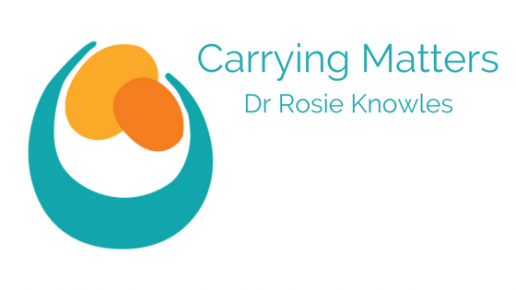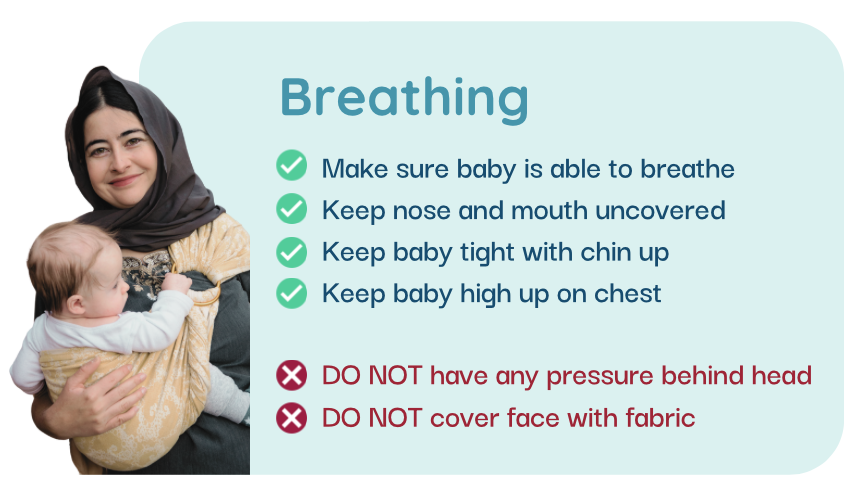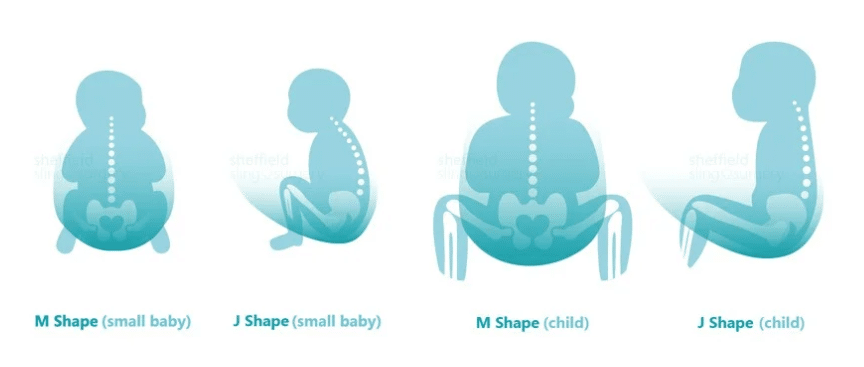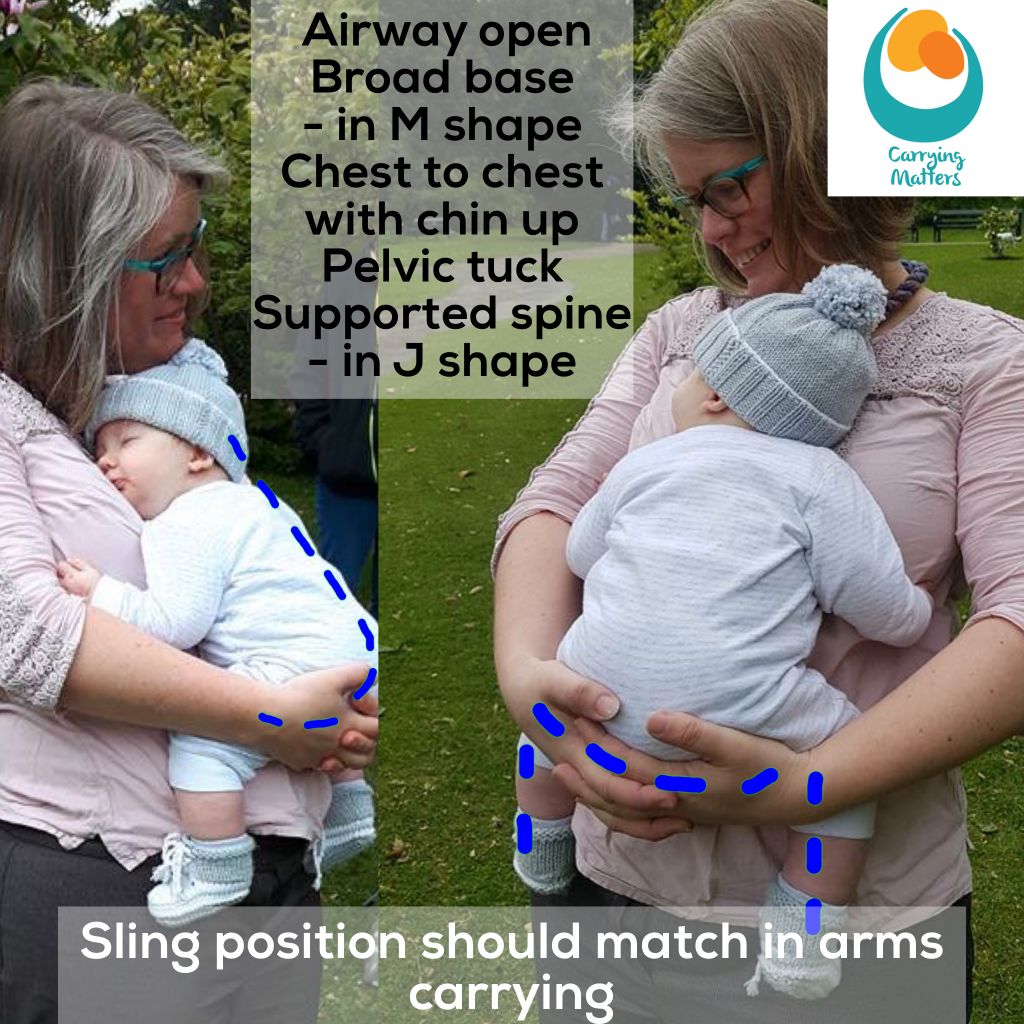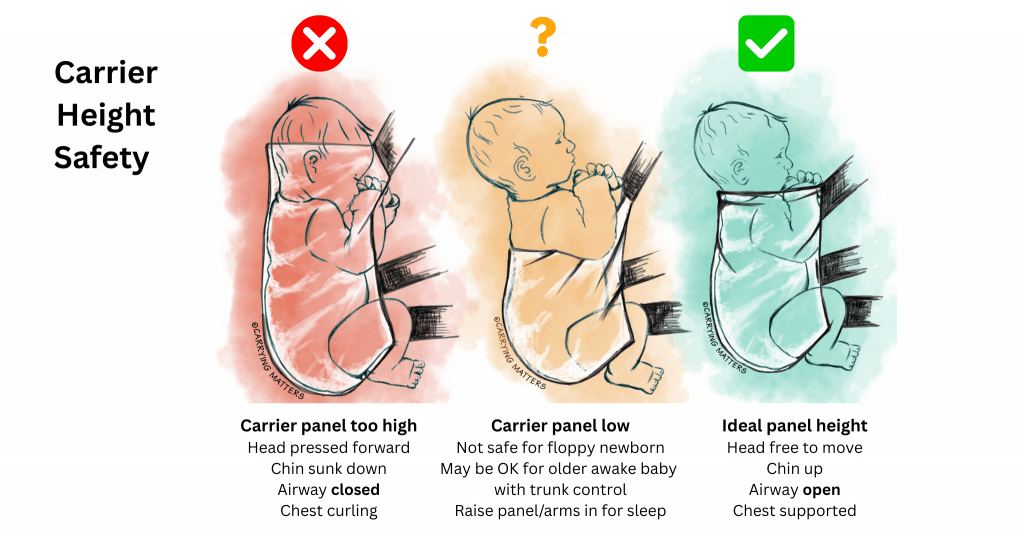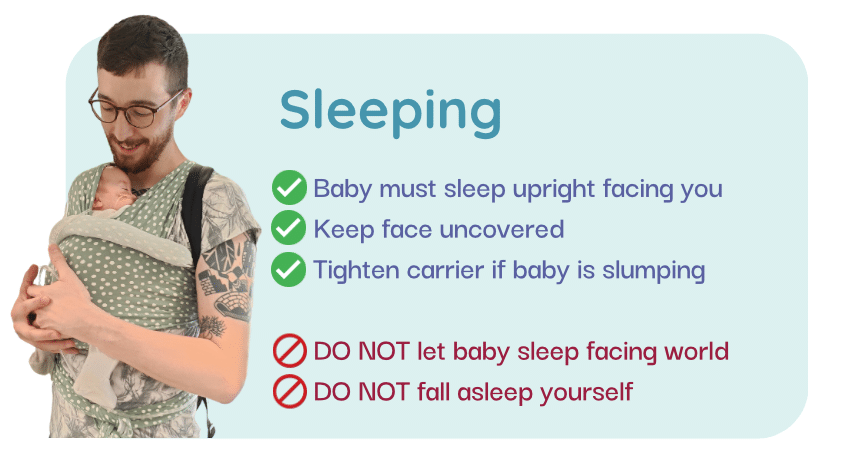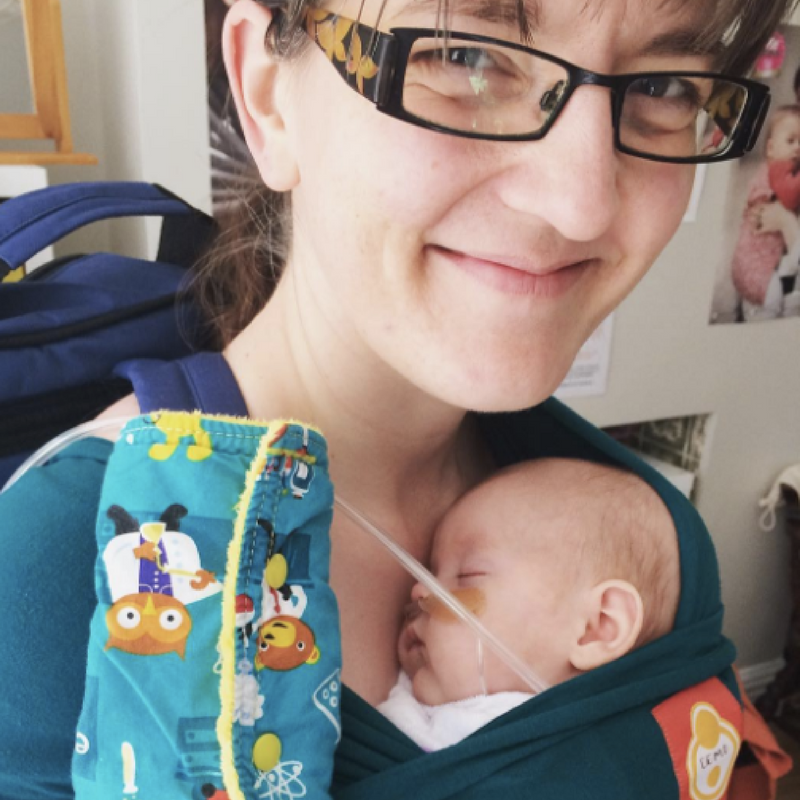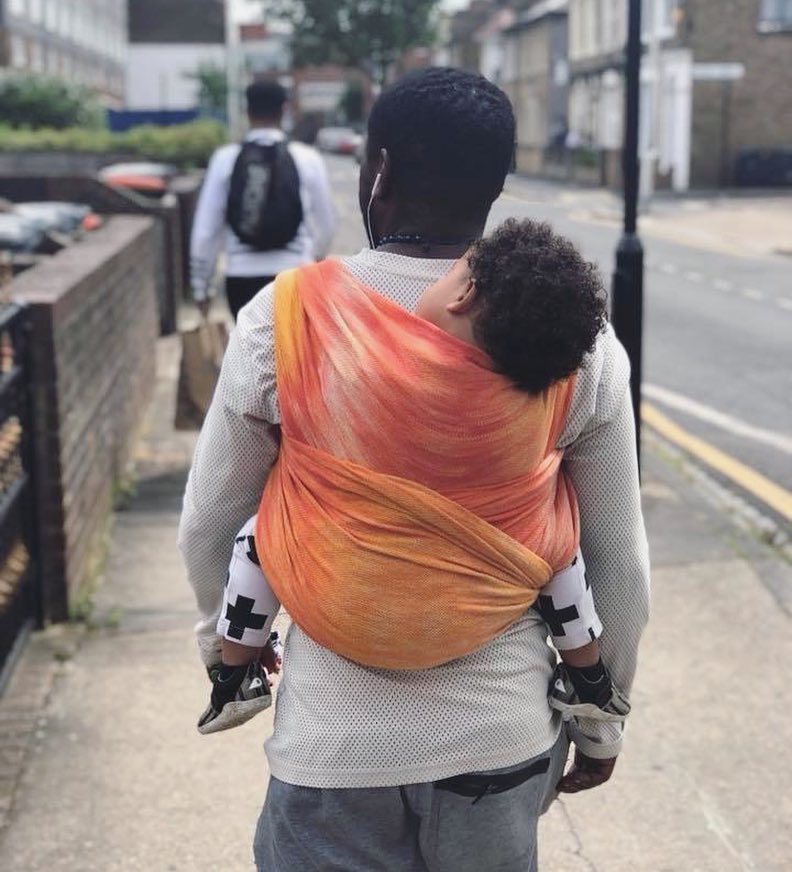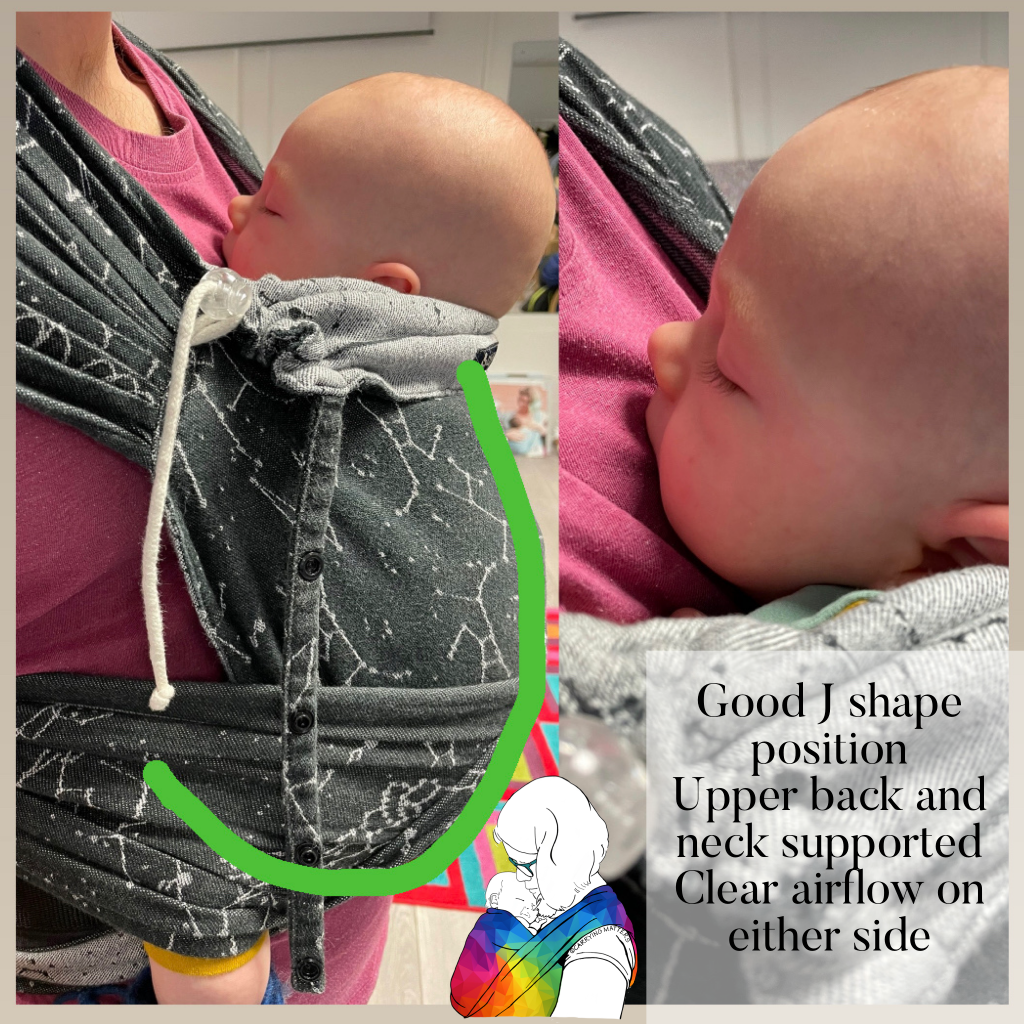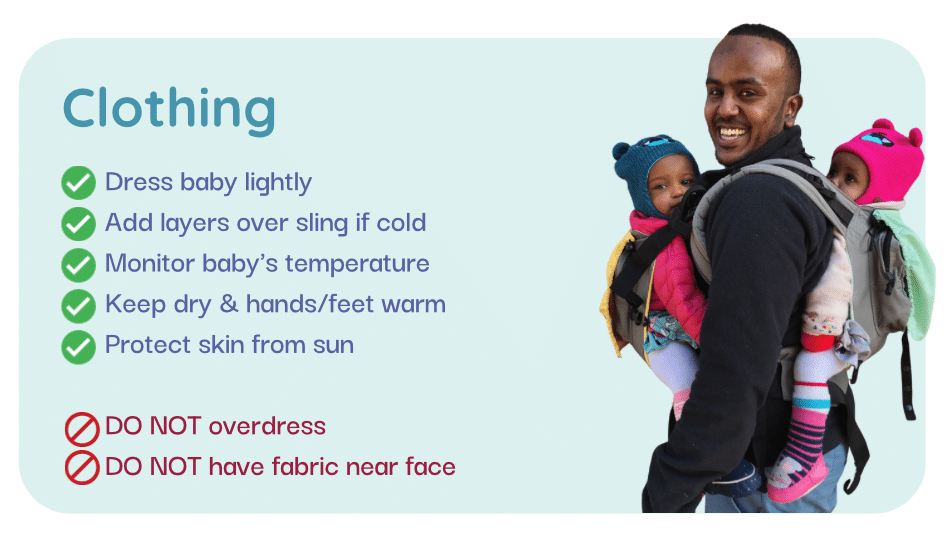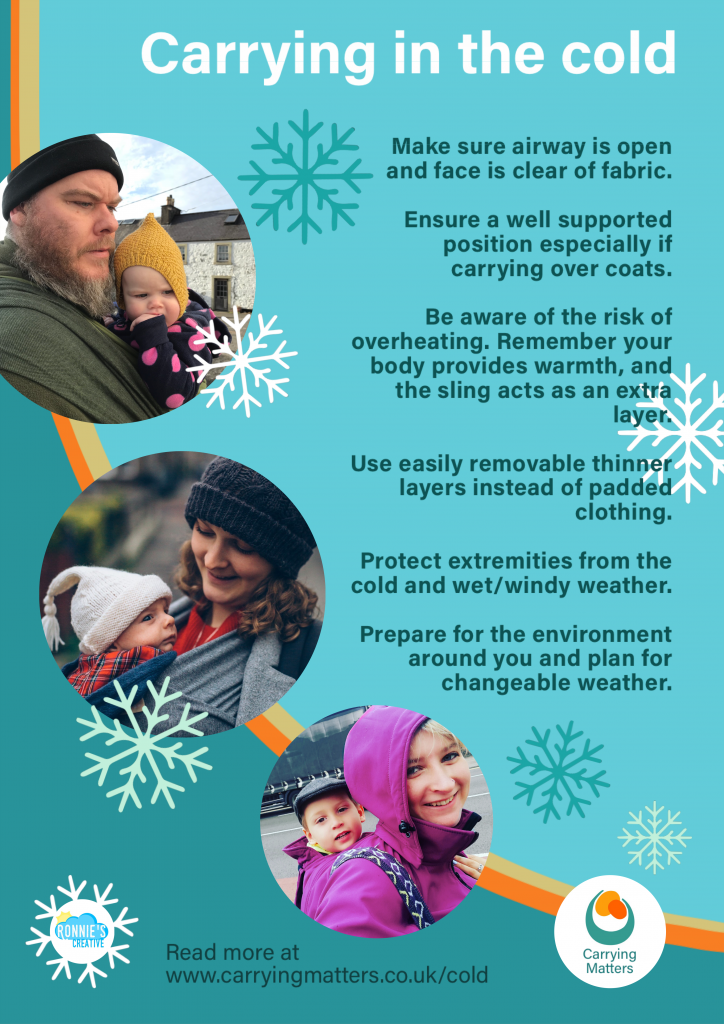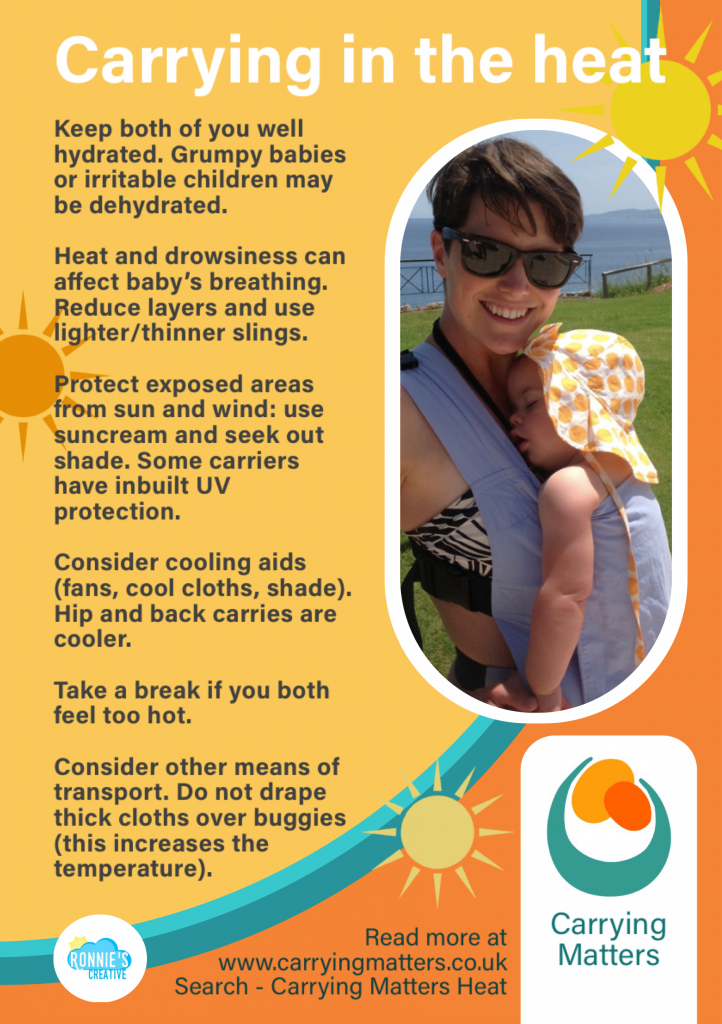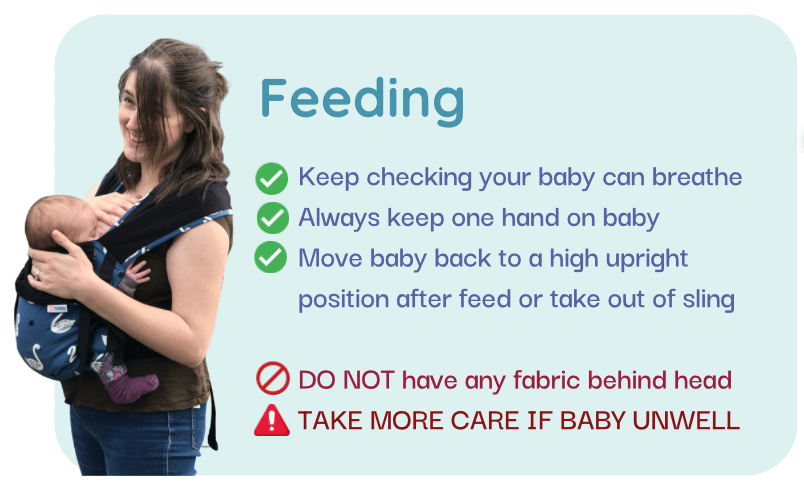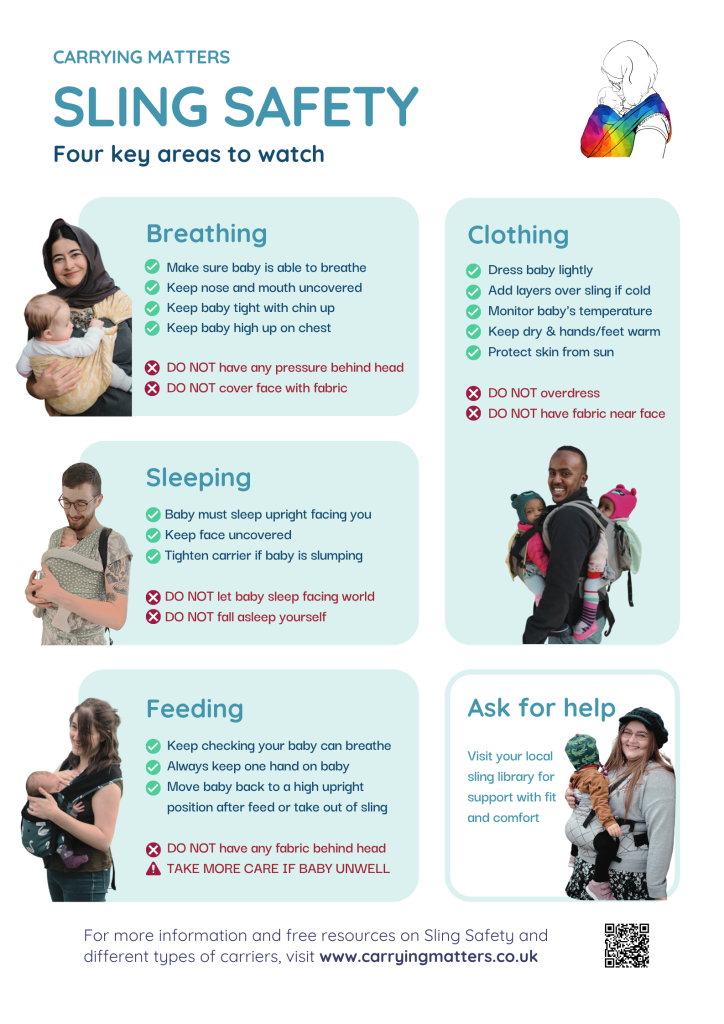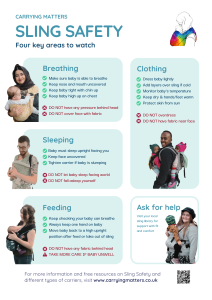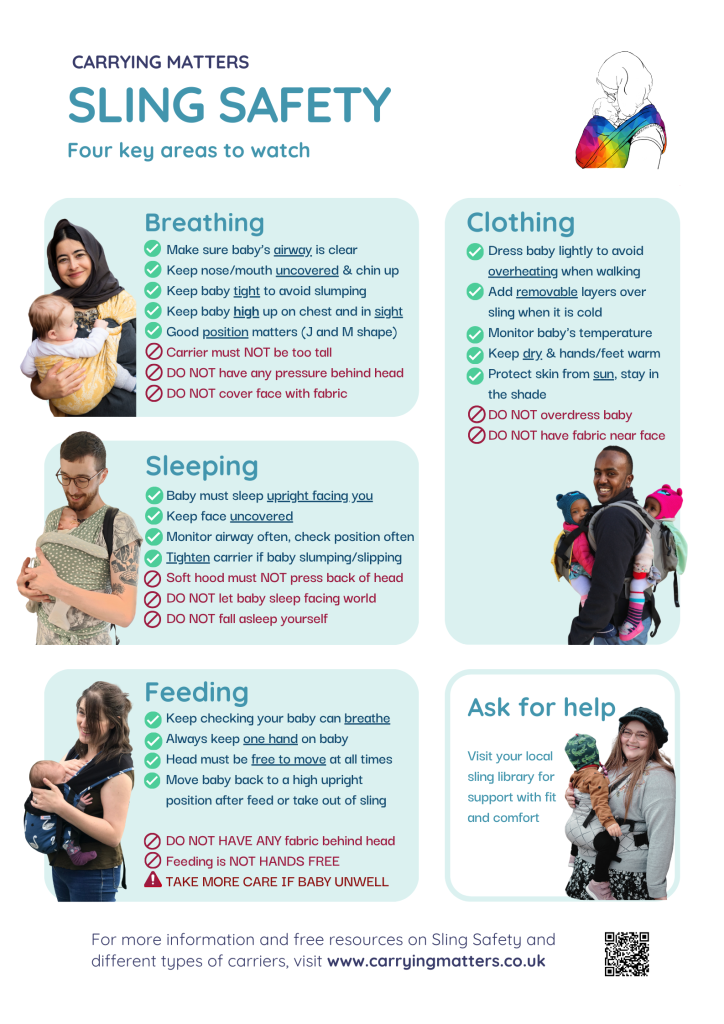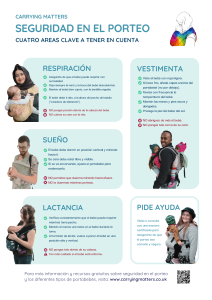Many babies and children love to be carried. It can be done safely and well. What are the key things to be aware to keep baby safe?
There are four key areas. Breathing, Sleeping, Clothing and Feeding.
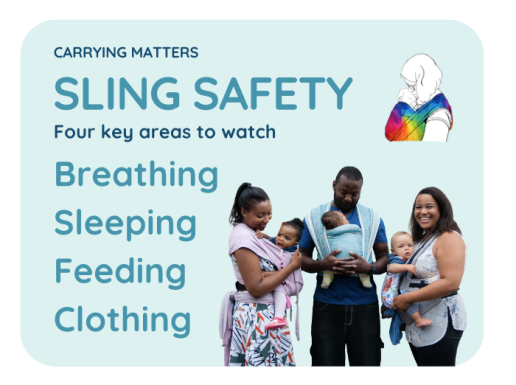
Breathing
This is the most important element of all – babies must be able to breathe safely in their carriers at all times. Nothing must block their nose or mouth, or press on their throat.
Some poorly designed carriers can compromise babies’ airways by being too loose, too low, or allowing horizontal carrying (where baby is lying down inside the sling.) Babies should not be placed in such carriers.
Babies must be held snugly upright with their chests supported against the parent at all times. There should be no gap so they cannot slump forward and roll into a curved C shape with their chin on their chests and airway folded over. The “gentle J shape” is a good way to think about it – baby’s spine is supported upright with head up, and there is a curve at their lower back and bottom for them to sit comfortably in a seated squat position, the “M shape“. This can be created by the “pelvic tuck”, ie rotating baby’s hips at the pelvis to bring their knees up and their bottom down to create the “froggy” M shape. Read more about the pelvic tuck here.
This is what it looks like in arms.
Carriers that are have too high a back will cause airway compromise. Babies should never have any restrictive fabric behind their heads. This is especially important when they are are sleeping or being fed in a carrier. A good guide is no higher than the nape of the neck, or below the earlobes.
The carrier should be tight and snug. A good guide is if you can fit only the flat of your hand between your baby’s chest and your body. If there is a wider gap, baby can slump over and compress their airway, so the carrier should be made tighter around baby’s back to support their spine. This will help to avoid slumping or flopping.
Baby should be carried high up on the front so their noses are on the flat hard upper part of your chest. This prevents any breast tissue from blocking their nose.
Babies must be in sight at all times, so you are aware of their breathing. Their nose and mouth must always be free of any fabric or tissue. The support for their heads comes the tightness of the carrier across the upper back, not from any fabric behind the head. You should not need to use any “head support”, however if you do use a hood or a layer of soft fabric when baby is asleep, it must not have any pressure to push head forward and tip the chin downwards. You must monitor any changes of head position and adjust the hood to keep face free of fabric.
The well known TICKS guidance is focused on ensuring a good airway, link here. (It does not cover all the aspects of safe sling use, however.)
Sleeping
It is important to be aware of your baby’s activities and to notice when they start to fall asleep so you can take action to keep them safe and comfortable.
Babies lose muscle tone when they sleep. This can mean that a carrier that fits around them while they are awake and holding themselves upright will become looser and start to sag when they fall asleep. Babies will then slump into this extra space, which can make their head fall forwards onto their chin, compromising their airway.
A baby who is sleeping curled up inside a carrier with their chin sunk onto their chest will also get very warm and this will also put them at risk. Do not let your baby slump in their sling.
If you notice your baby is tiring or has fallen asleep, adjust the carrier to be tighter and more supportive around their back. There should be no more than the flat of your hand between baby’s chest and your body. If your baby is asleep on your back and lolling backwards, lean your body forwards to bring them to rest on your back again, and then tighten.
Your child can sleep facing you on your front, on your back, or on your hip in a hip carrier (eg a ring sling) as they can rest their cheek against you.
The support for sleepy, floppy heads should come from the tightness of the carrier across the upper back, and good positioning, so adjust your baby and carrier to provide this if needed rather than using fabric/head rests/raising the height of the carrier. If their head is still lolling backwards, you can use your hand to support their head, or use one side of the hood or a layer of soft fabric to support their turned head gently. NEVER cover face with fabric.
If you do use a hood or a layer of soft fabric when baby is asleep, it must not have any pressure to push head forward and tip the chin downwards. You must monitor any changes of head position and adjust the hood/soft layer to keep face free of fabric.
If baby is face planting or frequently changing head position, you will need to ensure good airflow on either side of their face and no pressure behind the head, to ensure nose and mouth are not blocked.
Read more about face planting in slings here. This video shows you how to twist the fabric layers of a stretchy wrap to keep both sides of face clear.
If your baby is facing out (world-facing) in their carrier and is falling asleep, you must turn them around to sleep facing you. It is not safe to sleep facing out as baby’s chin will hang over the carrier panel and compress their airway. Read more about facing out in carriers here.
Do not fall asleep yourself while your baby is asleep in their sling. You must remain alert and responsive to their needs at all times. If you feel yourself getting drowsy, take baby out of the carrier and place them somewhere safe to sleep. Read more about sleeping in slings here.
Clothing
Your clothing must never cover your baby’s face, so that their nose and mouth is never blocked. You may need to choose different clothing if you are putting your baby in a sling, for example, no loose scarves around your neck, fabric must be smooth and kept away from their face.
Babies are unable to control their own temperature in the first few months of their lives, so you will need to monitor this often. It is easy for a baby to overheat in a carrier especially if your own body temperature is warm, and if you are heating up with walking. Babies that are too hot will find it harder to breathe.
Check your baby’s temperature often by feeling how warm their chest is and watching to see if their face is getting redder.
It is best to dress baby lightly, and add removable layers over you and the sling. These layers can then be easily removed when everyone starts to get too hot, without having to take baby out of the carrier.
Keep dry in the rain with waterproof outers that do not cover baby’s face, and umbrellas are useful.
Carrying in the cold
Do not put your baby in a carrier if they are wearing fluffy snowsuits, as babies get hot in them and they are hard to remove. Additionally, such snowsuits are often too large for small babies and they can sink down into the fluffy fabric and get their nose and mouth blocked. This is an airway compromise.
Head, hands and feet can be kept warm with hats and gloves and socks. Ensure any hats cannot slip to cover baby’s face. Do not use scarves, they can become too tight.
Read more here about how to care for your baby in the sling in cold weather.
Carrying in the heat
In hot weather, you will need to ensure you and your baby remain hydrated with extra feeds or fluids. Protect their skin from the sun with coverings and shade. Sun cream is not suitable for babies under six months, shade is best. Use light clothing, and choose a carrier that is not too thick or padded. Read more about how to care for your baby in hot weather here.
Make sure clothing fits baby well
- Fluffy oversized snowsuits can ride up at the neck to cover baby’s face while they are in the carrier and obstruct airway
- Onesies are often drawn up at the bottom when baby is sitting in a carrier, this may pinch at the toes. Adjust if needed.
- Avoid becoming too warm as this can worsen eczema
- Some carriers may rub against baby’s skin at the knee creases, so ensure baby is wearing protective clothing if needed
- Over-bulky cloth nappies or too thick or tight trousers can impair the fit of a carrier and cause pinching at the top of the legs which can impact blood flow
- Do a good pelvic tuck to keep baby’s weight resting on their bottom rather than at the knees, this helps to reduce irritation and pressure, and also reduces the risk of red marks to the lower legs
Feeding
Parents often ask if they can feed in their carrier. Feeding in slings can be very helpful for parents to remain on the go with their children who may need food at regular intervals. It must be done safely as there are extra risks to the airway with feeding in a sling.
It is important that baby remains able to breathe at all times during the feed. Babies breathe through their noses so anything that can block the nose will compromise their airway. Do not have any fabric or any head rests behind baby’s head when feeding, they must be able to move their heads easily in all directions.
It is not hands free.
Always keep one hand on your baby during the feed, keep checking on them and be sure you can see their breathing.
It is important to be more careful and monitor baby more closely if baby has a cold.
Once the feed is over, do not let your baby sleep in this position, however comfortable they are. Move them back to a high and tight position upright on your front, or take them out of the carrier altogether.
Read more about safe feeding in slings here.
Further help
If you would like some more support to carry your child safely, or have any questions, please seek help from your local sling library or consultant.
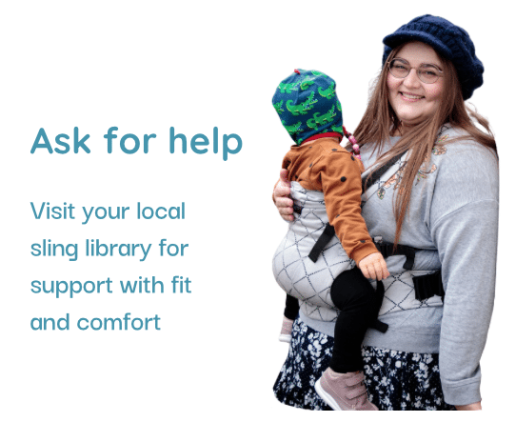
Would you like a copy of this leaflet or its variants?
They can be downloaded from the images below.
Standard leaflet
Leaflet with a gap to add your library or contact details
In depth version (good for educational purposes)
Spanish translation – with thanks to Veronica Cortez

